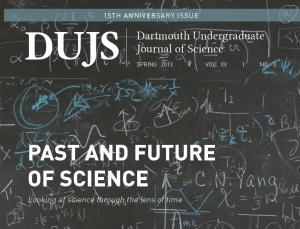 Dear Reader,
Dear Reader,
This year marks the 15th anniversary of the Dartmouth Undergraduate Journal of Science. Since our founding in 1998, the DUJS has helped unify the undergraduate science community at Dartmouth. We provide an interdisciplinary forum to share research and to inspire students to pursue the sciences and science writing. To this end, the past year has been an especially busy time for the DUJS. We have focused on expanding our influence beyond Hanover. Last spring, we launched our International Science Essay Contest for high school students and received over 80 submissions from 20 countries. Additionally, the DUJS has expanded its readership over the past year. We now distributed our print journals to over 20 universities and several countries overseas including Tsinghua University in Beijing. Our new website, sites.dartmouth.edu/dujs, has also begun receiving visits from viewers all over the world.
To match these expansions, our staff and editorial board membership has increased. This has allowed us to expand our content, beyond Dartmouth-related news, to include general science news, feature stories, and comics, all updated on a weekly basis online. New designs for our journal have also been implemented, with our expanded design staff. This 15th anniversary thus marks a high point for the DUJS. Looking back to our first issue, we are encouraged that the next 15 years of Dartmouth science will be as great as the past 15.
The theme of this commemorative issue is “The Past and the Future of Science.” The articles in this volume look at the past, present and future of a variety of topics in the sciences. Shawn (Yifei) Xie talks about the evolution of space programs. Annie (Yi) Sun describes the timeline of energy in the United States. Harrison Han dissects the history of epidemics. And Michael (Siyang) Li addresses advances in Moore’s Law. Olivia Dahl also analyzes the effect of psychostimulants on human physiology, and Mackenzie Foley reviews the development and future of genetics. Our interview of this issue features Jon Denning, a Ph.D candidate in the Dartmouth Computer Science Department. Denning’s research interests focus on studying 3D content creation and design workflows (primary focus), material visualization, and the perception of lighting and shadows.
This issue we also feature three external original research submissions. Dartmouth students Chris Hoder and Ben Southworth describe forecasting precipitation in Hanover, NH using neural networks. Benjamin Kessler, Milo Johnson and Wales Carter focus on the nature of interactions between Nasutitermes ephratae and Eciton burchelli. And Jonathan Guinther describes the process of mapping river flow with sensor swarms.
The growth of the DUJS over the years is a direct consequence of the hard work and dedication of countless writers, editors, staff members, and faculty advisors. We would like to take this opportunity to thank all of our contributors for helping make another excellent year.
Thank you for reading the DUJS, and we hope you enjoy this issue.
Sincerely,
The DUJS Editorial Board